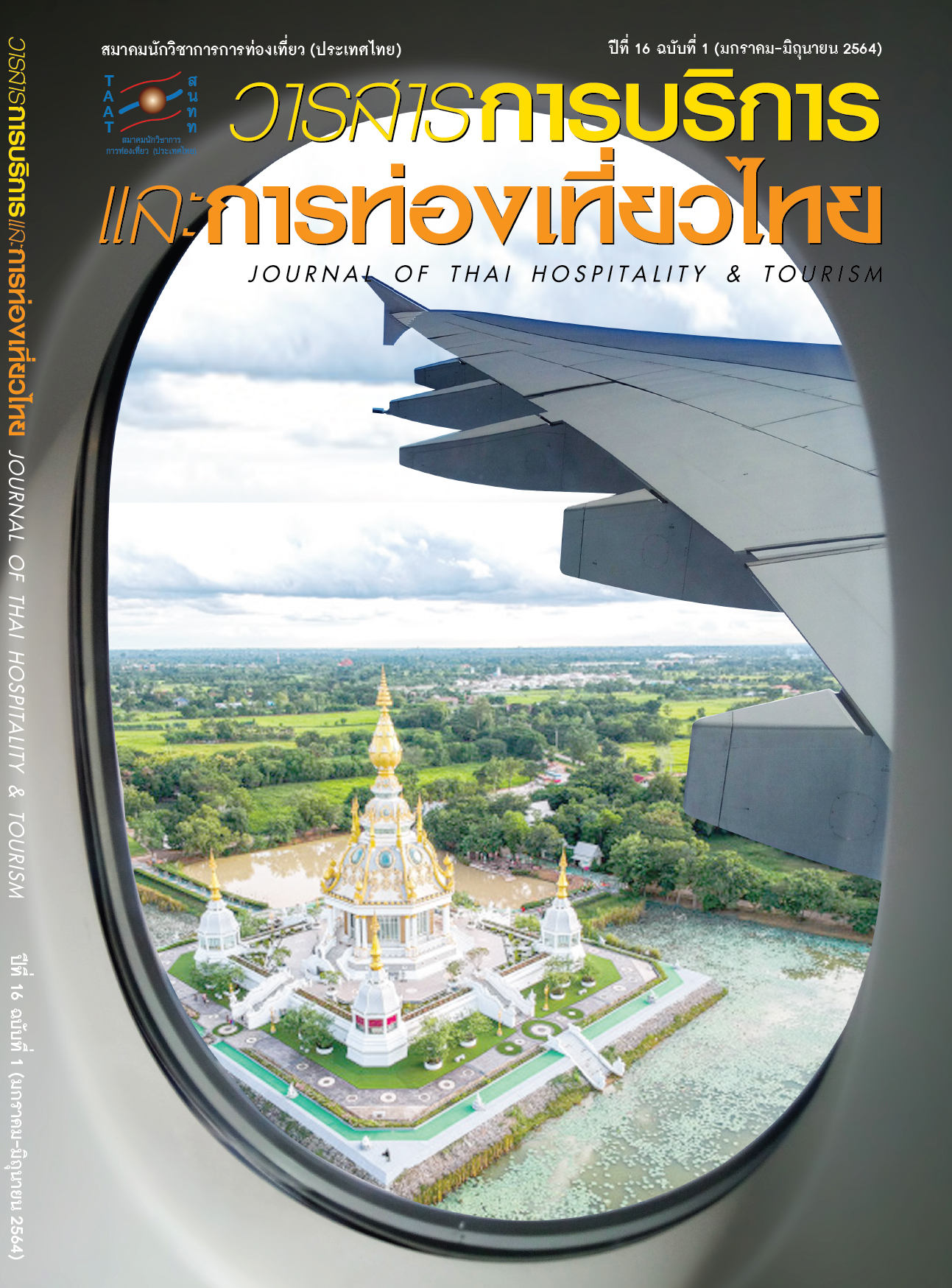A Study of Tourism Policy Implementation: A Case Study on Tourism Development in Chao Lao Beach, Laem Sadet Beach and Kung Krabaen Bay, Chanthaburi Province
Main Article Content
Abstract
This research article has two objectives which are: 1) to study problems and hindrances in tourism policy implementation, and 2) to study the participation of local communities and the private sector in tourism development in Chao Lao Beach, Laem Sadet Beach, and Kung Krabaen Bay in the Chanthaburi province of Thailand. The researcher has employed a qualitative research method by conducting documentary reviews, undertaking focus group discussions, and performing an in–depth interview.
It was found that the National Tourism Development Plan 2012–2016 is rarely applied to the strategic planning process. The organizational structure of the Ministry of Tourism and Sports which originated by the Office of the Public Sector Development Commission causes problems and hindrances in administration and policy implementation. A collaboration between the Chanthaburi Governor Office and the local administrative organization is a showing of unity, and the result of a lack of publicity and promotion in tourism. The result of not having an office of the Tourism Authority of Thailand (TAT) in the province, tourism policies, lack project continuity, and government regulations become a constraint on tourism development, and the organizational budgets and human resources are insufficient. For the participation of the local communities and the private sector, it was found that the private sector is strong enough and plays an important role in tourism development and management while the local communities have a low rate of participation in tourism development.
Article Details
References
Aref, F. (2011). Sense of Community and Participation for Tourism Development. Life Science Journal, 8(1), 20–25.
Aref, F., Ma’rof, R. & Sarjit, S. G. (2010). Dimensions of Community Capacity Building: A Review of Its Implications in Tourism Development. Journal of American Science, 6(1), 172–180.
Berman, P. (1978). The Study of Macro and Micro Implementation. Public Policy, 26(2), 157–184.
Bowen, G. L., Mancini, J. A., Martin, J. A., Ware, W. B. & Nelson, J. P. (2003). Promoting the Adaptation of Military Families: An Empirical Test of A Community Practice Model. Family Relations: An Interdisciplinary Journal of Applied Family Studies, 52(1), 33–44.
Brewer, G. D. & De Leon, P. (1983). The Foundations of Policy Analysis. Illinois: The Dorsey Press.
Bucker, J. C. (1988). The Development of An Instrument to Measure Neighborhood Cohesion. American Journal of Community Psychology, 16(6), 771–791.
Chanthaburi Governer Office. (2013). Chanthaburi Provincial Development Plan 2014–2017. Retrieved from http://www.chanthaburi.go.th/new/?page_id=9126
Chapman, M. & Kirk, K. (2001). Lessons for Community Capacity Building: A Summary of the Research Evidence. United Kingdom: Scottish Homes.
Creighton, J. L. (1992). Involving Citizens in Community Decision Making: A Guidebook. Washington: Program for Community Problem Solving.
DeNeui, D. L. C. (2003). An Investigation of First–Year College Students’ Psychological Sense of Community on Campus. College Student Journal, 37(2), 224–234.
Department of Tourism. (2016). Tourist Statistics and Tourism Revenue. Bangkok: Ministry of Tourism & Sports.
Devine, A. & Devine, F. (2011). Planning and Developing Tourism within A Public Sector Quagmire: Lessons from and for Small Countries. Tourism Management, 32(6), 1253–1261.
Dodds, R. & Butler, R. (2010). Barriers to Implementing Sustainable Tourism Policy in Mass Tourism Destinations. Tourismos: An International Multidisciplinary Journal of Tourism, 5(1), 35–53.
Lasker, R. D., Weiss, E. S. & Miller, R. (2001). Partnership Synergy: A Practical Framework for Studying and Strengthening the Collaborative Advantage. Milbank Quarterly, 79(2), 179–205.
Levi, Y. & Litwin, H. (1986). Community and Corporations in Participatory Development. Aldershot: Gower.
Mazmanian, D. A. & Sabatier, P. A. (1989). Implementation and Public Policy. Lanham: University Press of America.
Ministry of Tourism & Sports. (2011). National Tourism Development Plan 2012–2016. Retrieved from http://www.mots.go.th/ewt_dl_link.php?nid=4147
Ministry of Tourism & Sports. (2015). Thai Tourism Strategy 2015–2017. Retrieved from http://www.mots.go.th/ewt_dl_link.php?nid=7114
Okazaki, E. (2008). A Community–Based Tourism Model: Its Conception and Use. Journal of Sustainable Tourism, 16(5), 511–529.
Sombat Thamrongthanyawong. (2011). Public Policy: Theory, Analysis and Processes. 23rd ed. Bangkok: Sematham.
United Nations Environment Programme & World Tourism Organization. (2005). Making Tourism More Sustainable: A Guide for Policy Makers. Retrieved from http://www.unep.fr/shared/publications
/pdf/DTIx0592xPA-TourismPolicyEn.pdf
Van Meter, D. S. & Van Horn, C. E. (1975). The Policy Implementation Process: A Conceptual Framework. Administration and Society, 6(February), 445–487.
World Tourism Organization. (2004). Indicators of Sustainable Development for Tourism Destination: A Guidebook. Retrieved from http://www.adriaticgreenet.org/icareforeurope/wp-content/uploads/
/11/indicators-of-sustainable-development-for-tourism-destinations-a-guide-book-by-unwto.pdf


